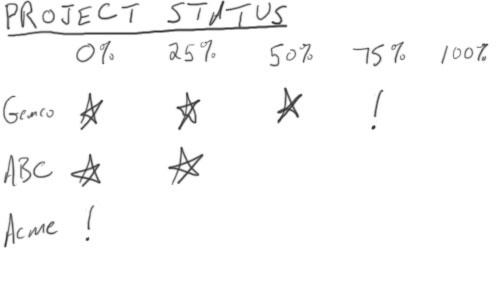When you have a new idea and you’re not sure it will work, create a tangible version of it as quickly as humanly possible. Even if it is very rough, something tangible helps you reach a solution.
I’m sure you’ve been in this situation. There’s an important problem that needs to be solved before the team can move on with other work. It’s a complex issue, maybe it’s charged with emotions, and no one has an answer. You and your team stare at the paper, out the window, or up at the ceiling wondering how anyone could possibly purchase such an ugly light fixture. Short of the day ending or receiving divine inspiration, it is at this point that you should pick up a pencil/marker/keyboard/tool/whatever and do the easiest thing you can imagine that would solve the problem.
When you’re trying to solve a problem and you’re stuck it’s because you’re trying to solve it in your head. Just as you can do simple calculations in your head but need a calculator for everything else, you can’t solve tough business problems in your head.
When you draw, build, write, or use something that is physical, your physical senses help you understand more about the situation. You more fully understand the problem than if you only thought about it. Financial analysts do this by writing calculations on the back of a napkin or playing with numbers in a spreadsheet. Designers do this by sketching on paper or carving foam in the shape of a product. Engineers do it by combining parts they have on hand to make something new.
This is not about conceiving a six billion dollar payroll system or a drug that cures cancer. It’s a way to make progress on one particular idea. It’s about making a physical thing you create quickly, learn from, and throw away.
It’s important to ignore how well you’re doing what you’re doing, because that will distract you from accomplishing the goal. This may go against our usual inclinations to do things “right.†We’re taught to think things through and carefully design a solution. But when you’re stuck we need to overcome this tendency. Free your mind from all the rules you normally follow. Pick up the pencil and just sketch.
You might even use techniques you know to be incorrect because they help you move more quickly. This is good. The are only two guidelines here:
1. Do it quickly
2. Create something tangible
Try it now
When faced with a tough problem, start by working with the familiar, asking, “Is there something that already exists that addresses this problem? What sorts of things that already exist might address this problem?â€
It may help – even just to save face in front of co-workers – to start by saying out loud as you grab the pencil, “This is something we’ll throw away later, but for now let’s try drawing something that will solve the problem. We can create the actual solution later.â€
——
This has been adapted from:
The Simplest Thing that Could Possibly Work, A Conversation with Ward Cunningham, Part V, by Bill Venners, January 19, 2004
Simplest or Easiest


